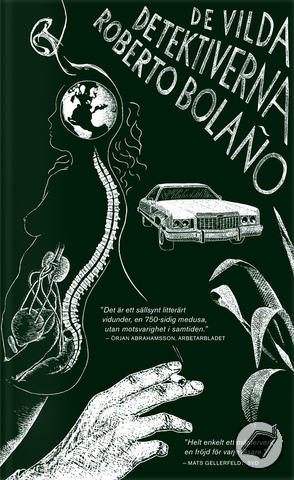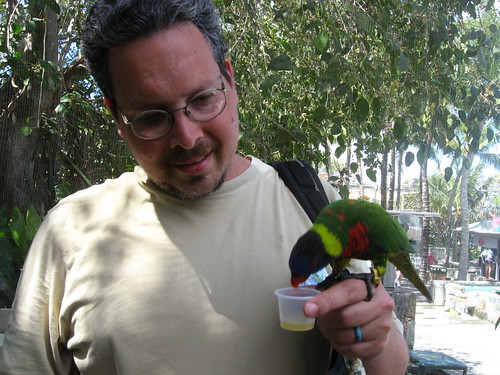|
|
Saturday, November 19th, 2011

De repente sentà que alguien me hablaba. DecÃan: señor Salvatierra, Amadeo, ¿se encuentra bien? Abrà los ojos y allà estaban los dos muchachos, uno de ellos con la botella de Sauza en la mano, y yo les dije que nada, muchachos, sólo me he traspuesto un poco...
— Amadeo Salvatierra
January, 1976
Amadeo Salvatierra's voice is one I could go on listening to for a long time without getting tired of it. His narratives seem to me to serve a special purpose in the vastness of part 2 of Savage Detectives, in that they keep the enclosing story of Belano et al. searching for Cesárea Tinajero front and center in the reader's mind. Below the fold, some lovely commentary from Salvatierra, in Natasha Wimmer's rendering, on the subject (near and dear to me) of mistranslation.
 Salvatierra is showing Belano and Lima his treasured copy of the old Visceral Realist journal Caborca.
...Cosmopolites that they were, the first thing they turned to were the translations, the poems by Tzara, Breton, and Soupault, in translations by Pablito Lezcano, Cesárea Tinajero, and yours truly, respectively. If I remember correctly, the poems were "The White Swamp," "The White Night," and "Dawn and the City," which Cesárea wanted to translate as "The White City," but I refused to let her. Why did I refuse? Well, because it was wrong, gentlemen. Dawn and the city is one thing and a white city is another, and that's where I put my foot down, no matter how fond I was of Cesárea back then. Not as fond as I should have been, I grant you, but truly fond of her all the same. Our French certainly left much to be desired, except maybe Pablito's. Believe it or not, I've lost my French completely, but we still translated, Cesárea in a slapdash way, if you don't mind my saying so, reinventing the poem however she happened to see fit, while I stuck slavishly to the ineffable spirit as well as the letter of the original. Naturally, we made mistakes, the poems wound up battered like piñatas, and on top of it all, believe me, we had ideas of our own, opinions of our own. For example, Soupault's poem and me. To put it simply: as far as I was concerned, Soupault was the greatest French poet of the century, the one who would go farthest, you understand, and now it's been years and years since I've heard a word about him, even though as far as I know he's still alive.
↻...done
posted morning of November 19th, 2011: Respond
➳ More posts about Roberto Bolaño
|  |
Thursday, November 24th, 2011

¿Ustedes han visto Easy Rider? Si, la película de Dennis Hopper, Peter Fonda y Jack Nicholson. Más o menos así éramos nosotros entonces. Pero sobre todo más o menos así eran Ulises Lima y Arturo Belano antes de que se marcharan a Europa.
— Rafael Barrios
March, 1981
Here is something that needs to be done: a bibliography should be compiled from Savage Detectives. Ideally it would include all real and fictional works mentioned in the text, with page references and contextual notes. I could do this... Maybe not now, but.
posted morning of November 24th, 2011: Respond
➳ More posts about Readings
|  |
Sunday, November 27th, 2011

Todo habÃa empezado, según Piel Divina, con una viaje que Lima y su amigo Belano hicieron al norte, a principios de 1976.
— Luis Sebastián Rosado
March, 1983
Piel Divina, homeless poet in Mexico City, puts together a paranoid narrative in which Lima has been pursued by some nameless, evil organization since the trip to Sonora; that his disappearance in Managua is part of his flight from the organization. Interesting... This is the approximate halfway point of the book, and we see Piel Divina putting himself forward as a detective. I had been thinking of the "savage detectives" as being Belano and Lima searching for Cesárea Tinajero; but this works too, and it makes the reader also into a savage detective, one on the trail of the visceral realists.When Piel Divina leaves Rosado's house, he takes with him some clothing and "a novel by Fernando del Paso", which given the date of Rosado's narration has to be either José Trigo or Palinuro de México.
 In Savage Detectives group read news, Rise links to a podcast of a reading at Symphony Space: Roberto Bolaño and the authors he admired, from last November.
posted morning of November 27th, 2011: Respond
|  |
|

¿Qué ocurre?, dije yo. No ocurre nada, todo se ha acabado, dijo Albertito.
— Luis Sebastián Rosado
February, 1984
It is good to know that Pieldivina's death in Savage Detectives is not part of the historical infrastructure of the book -- that he is alive and "in fact did not die a singularly depressing death of a brain tumor." He is (to my ear) a fantastic sculptor of syllables -- check out his poem "Tell them who you are", in both English (Brandon Holmquest's able rendering) and Spanish at that link.
posted evening of November 27th, 2011: 1 response
|  |
Tuesday, November 29th, 2011

...el Impala aún seguÃa aquÃ, por lo que deduzco quie actué con una velocidad sólo concedida a ciertos locos, y vi el Impala con mis gafas, esas gafas que hasta ese momento no sabÃa que poseÃa...
—Quim Font
August, 1987
The more I read from Quim Font's monologues, the more I like him. He is beginning to remind me of Amadeo Salvatierra, who I think is the only other narrator in the same age bracket... The two are not at all the same person, but they share a few endearing mannerisms.
 I'm knocked a bit for a loop by Andrés RamÃrez' monologue from December 1988. The first sentence is "I was destined to be a failure, Belano, take my word for it." (Wimmer's rendering -- had to look this up to make sure I was understanding correctly what he was saying.) This is the first time any of the narrators has addressed an interviewer by name -- so the interviewer here is Belano. But for a lot of reasons Belano cannot be the interviewer elsewhere...
posted evening of November 29th, 2011: Respond
|  |
Saturday, December third, 2011
photo by Sylvia Daniel Grossman, sentado en un banco de la Alameda, México df, febrero 1993.
posted afternoon of December third, 2011: Respond
➳ More posts about Pretty Pictures
|  |
Sunday, December 4th, 2011

Un poquito sublime y un poquito siniestro. Como en todo amor loco, ¿no? Si al infinito uno añade más infinito, el resultado es infinito. Si uno junta lo sublime con lo siniestro, el resultado es siniestro. ¿No?
—Felipe Müller
October, 1991
The narratives in the latter half of part 2 of Savage Detectives are spinning farther and farther away from the core of the book (which I stubbornly continue to insist is Belano and Lima's search for Cesárea Tinajero in 1975-6) -- long narratives by minor characters which involve Belano and Lima only glancingly or only in parts. Look at Felipe Müller's narrative from October, 1991 -- Müller summarizes a short story by Theodore Sturgeon, one which he is pretty sure Belano told him, "since he was the only one of our crowd who read science fiction."The story is "When You Care, When You Love" -- it strikes me as curious and interesting that a full three pages are spent on relating this story, more adjacent space than has been devoted to any other work referenced in this book so far. Add another entry to the long list of influences for Bolaño, I guess...
posted morning of December 4th, 2011: 2 responses
|  |
Monday, December 5th, 2011
In Savage Detectives Group Read news, Rise links to two videos: Laura Healy reading from Romantic Dogs, and Natasha Wimmer talking with Daniel Alarcón about how she discovered Bolaño's work. (Wimmer's biographical essay "Bolaño and the Savage Detectives" is online at Anagrama.)
posted evening of December 5th, 2011: Respond
➳ More posts about The Romantic Dogs
|  |
Tuesday, December 6th, 2011

Y Cesárea me miró, una mirada cortita, asà como de lado, y dijo que ése era el porvenir común de todos los mortales, buscar un lugar donde vivir y un lugar donde trabajar.
—Amadeo Salvatierra
January, 1976
While I was reading Amadeo Salvatierra's narrative this afternoon, it occurred to me to wonder whether he has ever referred to either of his two guests individually -- he is always saying things to "the boys" or recounting what they say to him, never (if memory serves) either one of the two by himself. A little funny because everywhere else in the book there seems to be a pretty strong distinction drawn between the two of them.
posted evening of December 6th, 2011: Respond
|  |
Wednesday, December 7th, 2011

Iñaki me miró y lugo miró el mar y sólo entonces comprendà que la escena tenÃa algo de irremediablemente ridÃculo y que lo ridÃculo no era ajeno a mi presencia allÃ.
—Jaume Planells
June, 1994
A couple of episodes in part 2 of Savage Detectives are retold several times by successive narrators/interviewees, from their different vantage points. I think these are my favorite parts of the book -- here Bolaño uses the form he has chosen to its fullest extent. One of these is Belano's ludicrous duel with Iñaki Echavarne, fought off-season on a nude beach near Barcelona sometime in the early 90's (as close as I can tell) -- it is told first by unsuspecting Susana Puig, Belano's nurse and lover when he was hospitalized for pancreatitis, then by Guillem Piña, who hatches the scheme with Belano and serves as his second, then by Jaume Planells, who is drawn in against his better judgement as Echavarne's second. I'd like to think about what it means that Duchamp's Nude Descending a Staircase #2 serves as a leitmotif for this episode. Piña repeatedly says he "felt like the Nude Descending a Staircase" in relation to Belano and that he "waited, which is what the Nude Descending a Staircase did" -- Planells picks up on this when he says he thinks Echavarne mentioned the painting when telling him about the duel, wonders "what did Picasso have to do with it?" And, well, I'm not sure what Picasso or Duchamp has to do with this absurd duel. The whole thing works nicely as a way of keeping the image in your mind when you're reading the episode, as a backdrop to its events. Bolaño has not used visual art this way very much in Savage Detectives -- many of the poems in Romantic Dogs have a painting as their centerpiece.
 I ran into a woman on the subway this morning who was reading The Skating Rink, and we chatted for a few minutes about how Bolaño is the greatest thing ever. That was fun.
posted evening of December 7th, 2011: 2 responses
| More posts about The Savage Detectives
Archives  | |
|
Drop me a line! or, sign my Guestbook.
•
Check out Ellen's writing at Patch.com.
| |

